Track
Almost all of the applications we use today incorporate a form of machine learning to enhance or automate a business process.
However, these models cannot simply be pushed to a live environment — especially in a high-stakes environment (i.e., predicting if someone has cancer). They must be optimized to operate efficiently and effectively before moving into production. This means the model parameters must be fine-tuned to ensure they contribute to an improved customer experience.
Practitioners typically use loss/cost functions to find the optimal solution for their machine learning model during training. Cross Entropy is one of the most popular loss functions used to optimize classification models.
In this article, we will dive deeper into:
- What is cross entropy?
- Calculating cross-entropy
- Cross entropy as a loss function
- Best practices.
Develop AI Applications
Understanding Entropy
The concept of cross-entropy traces its roots back to the field of information theory, where information entropy, also known as Shannon entropy, was formally introduced in 1948 by Claude Shannon in a paper titled “A Mathematical Theory of Communication.” Before we tackle cross-entropy, let’s deal with entropy.
Entropy calculates the degree of randomness or disorder within a system. In the context of information theory, the entropy of a random variable is the average uncertainty, surprise, or information inherent to the possible outcomes. To put things simply, it measures the uncertainty of an event.
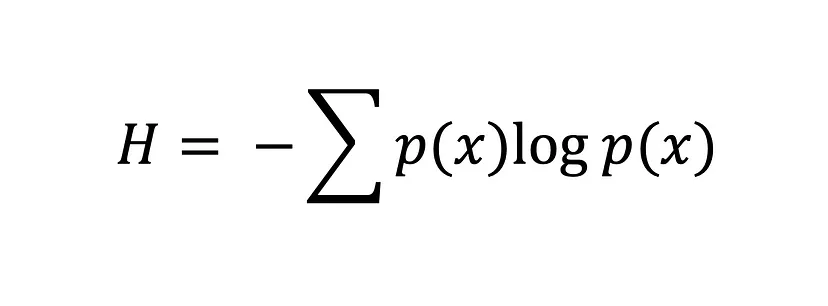
The Shannon entropy equation
The greater the value of entropy, H(x), the greater the uncertainty for the probability distribution, and the smaller the value, the less uncertainty.
What is Cross-Entropy?
Cross-entropy, also known as logarithmic loss or log loss, is a popular loss function used in machine learning to measure the performance of a classification model.
It measures the average number of bits required to identify an event from one probability distribution, p, using the optimal code for another probability distribution, q. In other words, cross-entropy measures the difference between the discovered probability distribution of a classification model and the predicted values.
The cross-entropy loss function is used to find the optimal solution by adjusting the weights of a machine learning model during training. The objective is to minimize the error between the actual and predicted outcomes. A lower cross-entropy value indicates better performance.
If you’re familiar with Kullback-Leibler (KL) Divergence, you may wonder, “What’s the difference between cross-entropy and KL divergence?” And that’s a fair question. Both concepts are widely used to measure probability distributions' differences or similarities. Although they share some similarities, they serve different purposes.
As mentioned above, cross-entropy measures the average number of bits required to identify an event from one probability distribution, P, using the optimal code for another probability distribution, Q, and is typically used in machine learning to evaluate the performance of a model where the objective is to minimize the error between the predicted probability distribution and true distribution.
In contrast, KL divergence measures the difference between two probability distributions, P and Q. Namely, KL divergence quantifies the amount of information loss when Q is used to approximate P. This is incredibly useful in unsupervised learning tasks where the objective is to uncover structure in data by minimizing the divergence between the true and learned data distributions.
Cross Entropy as a Loss Function
In machine learning, loss functions help models determine how wrong it is and improve itself based on that wrongness. They are mathematical functions that quantify the difference between predicted and actual values in a machine learning model, but this isn’t all they do.
The measure of error from a loss function also serves as a guide during the optimization process by providing feedback to the model on how well it fits the data. Hence, most machine learning models implement a loss function during the optimization phase, where the model parameters are chosen to help the model minimize the error and arrive at an optimal solution – the smaller the error, the better the model.
We can measure the error between two probability distributions using the cross-entropy loss function. For example, let’s assume we’re conducting a binary classification task (a classification task with two classes, 0 and 1).
In this instance, we must use binary cross-entropy, which is the average cross-entropy across all data samples:
Binary cross entropy formula [Source: Cross-Entropy Loss Function]
If we were to calculate the loss of a single data point where the correct value is y=1, here’s how our equation would look:

Calculating the binary cross-entropy for a single instance where the true value is 1
The predicted probability, p, determines the value of loss, l. If the value of p is high, the model will be rewarded for making a correct prediction - this will be illustrated with a low value of loss, l.
However, a low predicted probability, p, would infer the model was incorrect, and the binary cross-entropy loss function will reflect this by making the value of l higher.
For a multi-class classification task, cross-entropy (or categorical cross-entropy as it is often referred to) can be simply extended as follows:
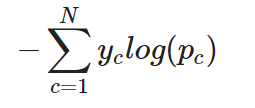
Categorical cross-entropy for a single instance
In other words, to apply cross-entropy to a multi-class classification task, the loss for each class is calculated separately and then summed to determine the total loss.
Implementing Cross-Entropy Loss in PyTorch and TensorFlow
In this part of the tutorial, we will learn how to use the cross-entropy loss function in TensorFlow and PyTorch.
Let’s start by creating the dataset. We will use Scikit learns make_classification function to help us:
from sklearn.datasets import make_classification
from sklearn.model_selection import train_test_split
# create training data
X, y = make_classification(
n_samples=10000,
n_informative=10,
random_state=2022
)
# split into train and test
X_new, X_test = X[:9000, :], X[9000:, ]
y_new, y_test = y[:9000], y[9000:]
X_train, X_val, y_train, y_val = train_test_split(
X_new, y_new,
test_size=0.3
)
print(f"Train data: {X_train.shape}\n\
Train labels: {y_train.shape}\n\
Test data: {X_test.shape}\n\
Test labels: {y_test.shape}")
"""
Train data: (6300, 20)
Train labels: (6300,)
Test data: (1000, 20)
Test labels: (1000,)
"""Cross-entropy in TensorFlow
The model we will build will consist of an input layer, a hidden layer, and an output layer.
Since this is a binary classification task, we will use binary cross-entropy as our loss function.
# building and training model
model = tf.keras.Sequential([
tf.keras.layers.Dense(10,
input_shape=(X_train.shape[1],),
activation="relu"),
tf.keras.layers.Dense(10,
activation="relu"),
tf.keras.layers.Dense(1, activation="sigmoid")
])
model.compile(
loss="binary_crossentropy", # loss function here
optimizer="adam",
metrics=["accuracy"])
history = model.fit(X_train, y_train, epochs=20, validation_data=[X_val, y_val], verbose=0)Next, we will plot the loss to see whether the model is improving – meaning the error decreases with each epoch until it can no longer improve.
# plotting the loss of the models
fig, ax = plt.subplots(figsize=(8,5))
plt.plot(history.history['loss'])
plt.plot(history.history['val_loss'])
plt.title('model loss')
plt.ylabel('loss')
plt.xlabel('epoch')
plt.xticks(np.arange(0,20, step=1))
plt.legend(['train', 'test'], loc='upper right')
plt.show()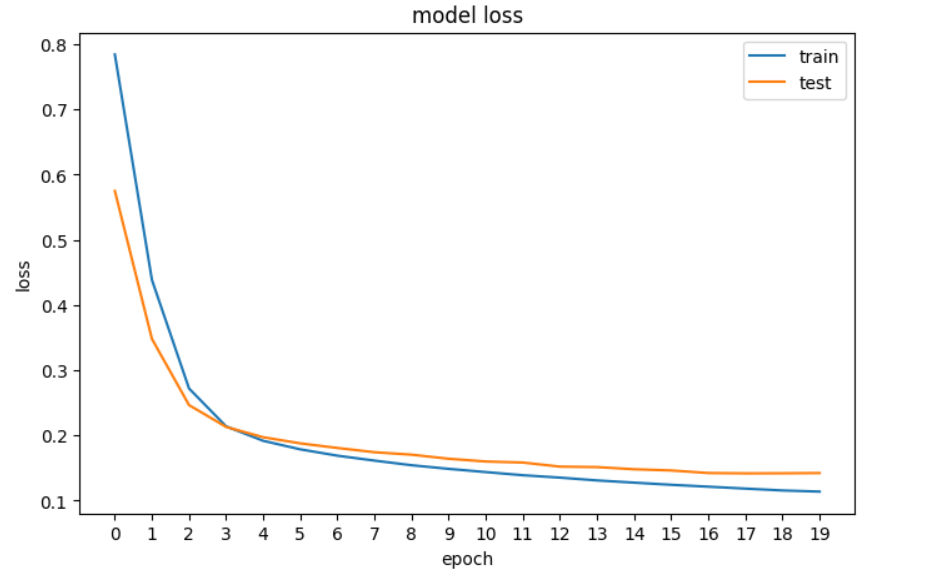
A plot of the loss of our neural network in TensorFlow.
Cross-entropy in PyTorch
In PyTorch, inputs, outputs, and parameters of the model are encoded using tensors, which means we must convert our Numpy arrays to tensors. That’s the first thing we do in the code below, and then we build the neural network and print its dimensions.
# convert numpy arrays to tensors
X_train_tensor = torch.tensor(X_train, dtype=torch.float32)
X_val_tensor = torch.tensor(X_val, dtype=torch.float32)
y_train_tensor = torch.tensor(y_train, dtype=torch.float32).reshape(-1, 1)
y_val_tensor = torch.tensor(y_val, dtype=torch.float32).reshape(-1, 1)
# build the model
input_dim = X_train.shape[1]
hidden_dim = 10
output_dim = 1
model = nn.Sequential(
nn.Linear(input_dim, hidden_dim),
nn.ReLU(),
nn.Linear(hidden_dim, hidden_dim),
nn.ReLU(),
nn.Linear(hidden_dim, output_dim),
nn.Sigmoid()
)
print(model)
"""
Sequential(
(0): Linear(in_features=20, out_features=10, bias=True)
(1): ReLU()
(2): Linear(in_features=10, out_features=10, bias=True)
(3): ReLU()
(4): Linear(in_features=10, out_features=1, bias=True)
(5): Sigmoid()
)
"""Next, we define the binary cross-entropy loss function and optimizer:
loss_fn = nn.BCELoss() # binary cross entropy
optimizer = optim.Adam(model.parameters(), lr=0.001)And now to plot the loss:
# plotting the loss of the models
fig, ax = plt.subplots(figsize=(8,5))
plt.plot(train_loss)
plt.plot(val_loss)
plt.title('model loss')
plt.ylabel('loss')
plt.xlabel('epoch')
plt.xticks(np.arange(0,20, step=1))
plt.legend(['train', 'test'], loc='upper right')
plt.show()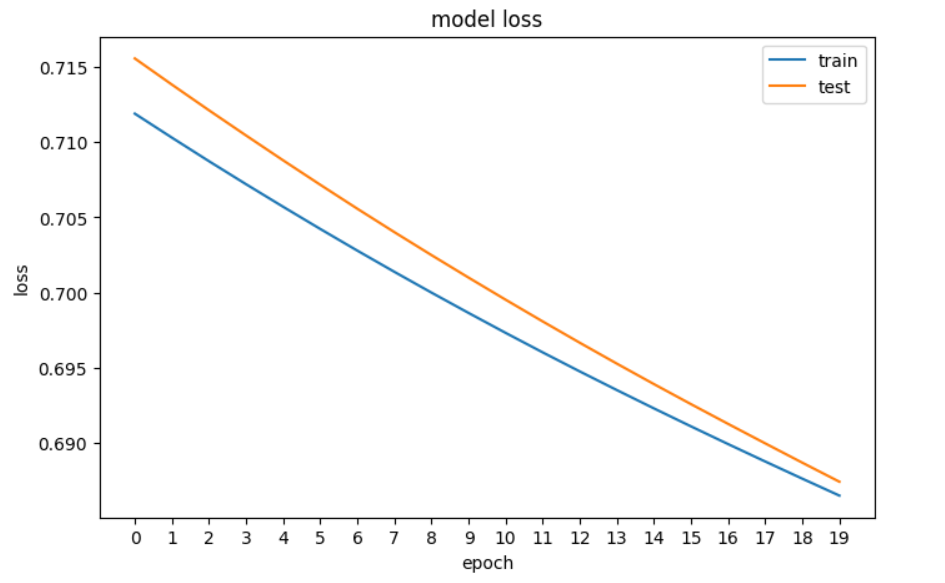
A plot of the loss of our Neural network in PyTorch
Key Takeaways
Here’s a quick recap of what we’ve learned about cross-entropy loss:
- Entropy calculates the degree of randomness or disorder within a system to measure the uncertainty of an event. If an outcome is certain, the measure of entropy will be low.
- Cross-entropy is a popular loss function used in machine learning to measure the performance of a classification model. Namely, it measures the difference between the discovered probability distribution of a classification model and the predicted values. When applied to binary classification tasks, it is commonly referred to as log loss.
- Binary cross-entropy is used when performing binary classification, and categorical cross-entropy is used for multi-class classification.
- Cross-entropy is similar to KL divergence, but they serve different purposes: cross-entropy is typically used in machine learning to evaluate the performance of a model where the objective is to minimize the error between the predicted probability distribution and true distribution, whereas KL is more useful in unsupervised learning tasks where the objective is to uncover structure in data by minimizing the divergence between the true and learned data distributions.
To continue your learning, check out our resources:
Earn a Top AI Certification

Cross Entropy FAQs
What is cross-entropy in machine learning?
Cross-entropy, also known as logarithmic loss or log loss, is a popular loss function used in machine learning to measure the performance of a classification model. It measures the difference between the predicted probability distribution and the true distribution.
How is entropy related to cross-entropy?
Entropy calculates the degree of randomness or disorder within a system, measuring the uncertainty of an event. Cross-entropy builds on this concept to measure the average number of bits required to identify an event from one probability distribution using the optimal code for another distribution.
What is the Shannon entropy equation?
The Shannon entropy equation calculates the entropy of a random variable, measuring the average uncertainty or information inherent to possible outcomes. A higher entropy value indicates greater uncertainty.
How does cross-entropy differ from KL divergence?
Cross-entropy is used to evaluate the performance of a classification model by minimizing the error between predicted and true distributions. KL divergence quantifies information loss when one distribution approximates another. KL divergence is often used in unsupervised learning tasks.
What is binary cross-entropy?
Binary cross-entropy is used for binary classification tasks. It calculates the average cross-entropy across all data samples.
How is categorical cross-entropy different from binary cross-entropy?
Categorical cross-entropy extends binary cross-entropy to multi-class classification tasks.
Why are loss functions important in machine learning?
Loss functions quantify the difference between predicted and actual values in a machine learning model. They guide the optimization process by providing feedback on how well the model fits the data. Read our guide, Loss Functions in Machine Learning Explained, to learn more.
What other kinds of loss functions are there in machine learning?
Other loss functions in machine learning include mean squared error (MSE) and mean absolute error (MAE) for regression tasks, hinge loss for support vector machines, Huber loss for robust regression, poisson loss for count data regression, and cosine proximity for tasks involving vector similarities. Read our post, What is Deep Learning? A Tutorial for Beginners, to learn more about loss functions and their place in machine learning.
How is the cross-entropy loss function implemented in PyTorch?
In PyTorch, the cross-entropy loss function is implemented using the nn.BCELoss class for binary classification tasks. The model is built using nn.Sequential with layers defined, and the optimizer is set up using optim.Adam. The loss is calculated during training to update the model parameters.


